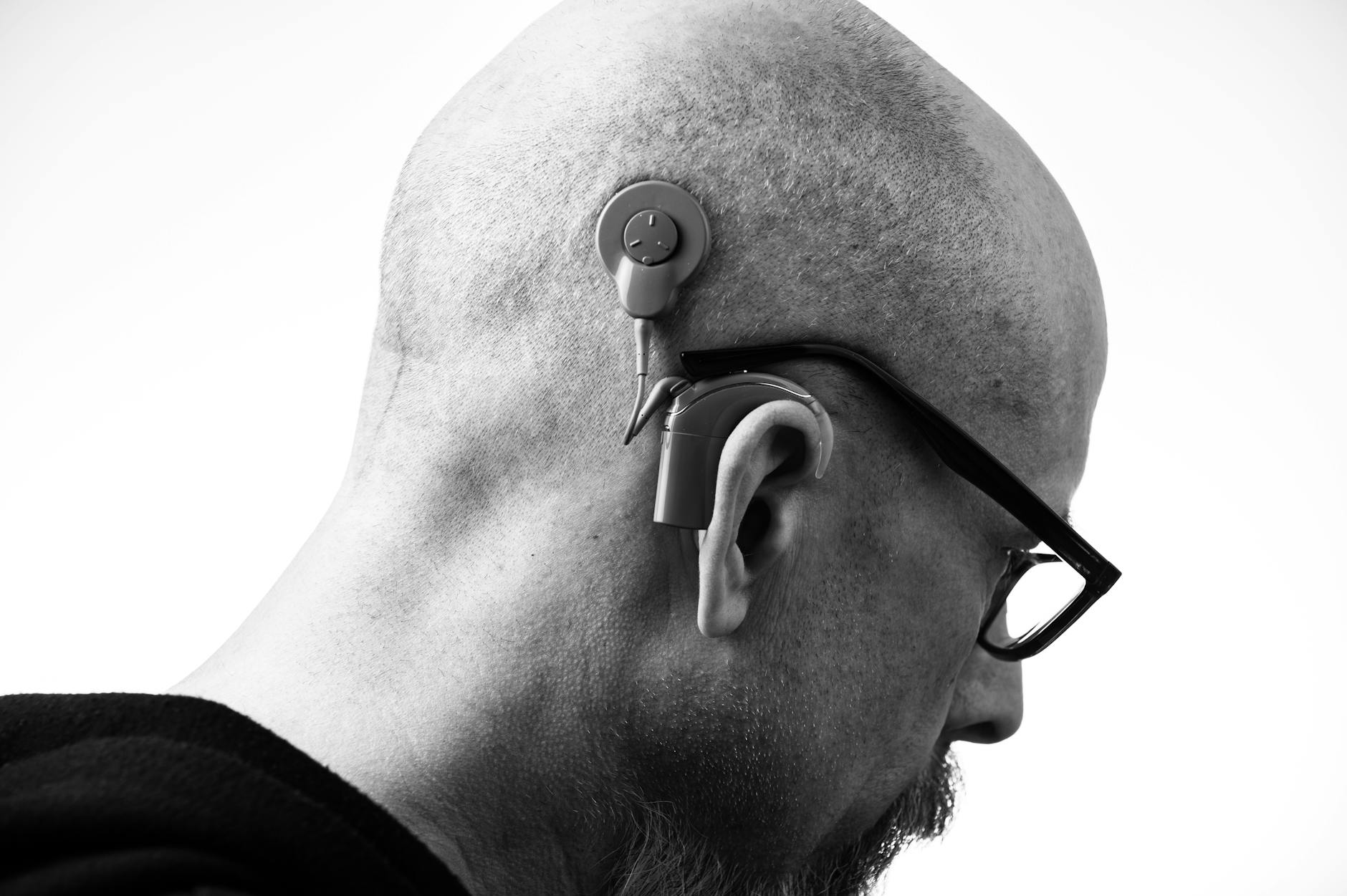If your ringing or buzzing changes when you clench your teeth, press your jaw joints, turn your head, or shrug your shoulders—you’re not imagining it. Your neck and jaw can feed signals into the hearing system and turn the volume up or down. The good news: when the body contributes, body-based care can help.
This guide gives you a practical, evidence-informed plan to reduce somatosensory tinnitus. We’ll show you how to spot it, what you can do today, and how audiologists, ENT specialists, dentists, and physical therapists can work together to calm the noise.
What is somatosensory tinnitus?
Tinnitus is the perception of sound without an external source. In somatosensory tinnitus, sensory input from the neck, jaw, or face—especially the temporomandibular joint (TMJ) and cervical spine—modulates activity in the brain’s early hearing centers.
How the neck and jaw talk to your ears
Nerve fibers from the trigeminal (face/jaw) and cervical (neck) systems connect with the dorsal cochlear nucleus, a hub that blends sound information with touch and movement signals. When those somatic inputs are overactive (think: clenched jaw, stiff neck, inflamed joints), they can bias the system and amplify tinnitus. Researchers have demonstrated that jaw/neck maneuvers can change tinnitus loudness or pitch in many people—strong evidence of this wiring in action.
Signs your tinnitus may have a somatic driver
- It changes with movement: clenching teeth, opening wide, pushing the lower jaw forward/back, turning/tilting the head, pressing on muscles around the jaw or neck.
- You have TMJ symptoms: jaw clicking, pain, morning jaw fatigue, limited opening, or bruxism (nighttime grinding/clenching).
- You have neck issues: stiffness, pain, whiplash history, forward-head posture, shoulder tension, headaches.
- Your tinnitus fluctuates with stress, poor sleep, or long desk days.
These aren’t a diagnosis. They’re clues that treating the body could turn the dial down.
First: rule out red flags
Before any self-management, check for issues that need prompt medical evaluation.
- Sudden hearing loss with or without tinnitus (develops over hours to a few days).
- Unilateral (one-sided) tinnitus with new hearing asymmetry, or tinnitus plus facial weakness or severe vertigo.
- Pulsatile tinnitus (a rhythmic sound in time with your heartbeat).
- New neurologic symptoms (double vision, numbness, severe headache).
If any of these apply, contact an ENT specialist or urgent care promptly. Otherwise, book an audiologist for a comprehensive hearing test to establish a baseline and discuss tinnitus care options.
Your treatment roadmap
Somatosensory tinnitus often improves most when you combine body care with sound-based and cognitive strategies. Think: quiet the body signals and retrain the brain’s response.
1) Treat the jaw (TMJ) if it’s part of the story
Start gentle. The goal is to reduce overload, inflammation, and clenching.
- Jaw relaxation: rest your tongue on the roof of your mouth behind your front teeth, lips together, teeth apart. Check in several times a day.
- Heat and self-massage: 10 minutes of warm compresses, then light circular massage over jaw muscles (masseter, temples).
- Reduce strain: avoid chewing gum, nail biting, and ultra-chewy foods for a few weeks.
- Post-meal stretches: slow, comfortable opening/closing, side-to-side glides within pain-free range.
- Nighttime protection: if you clench or grind, ask a dentist about a professionally fitted occlusal splint. Over-the-counter guards can help temporarily, but a custom fit is usually more comfortable and effective.
- Consider a specialist: orofacial pain dentists and physical therapists trained in TMJ disorders can guide targeted exercises, manual therapy, and habit change.
2) Calm the neck and shoulders
Neck input can be a powerful tinnitus amplifier. Improving posture, mobility, and muscle balance can lower the gain.
- Desk ergonomics: screen at eye level, chair that supports mid-back, feet flat, elbows at 90°. Set a 30–45 minute movement timer.
- Micro-moves, many times: chin tucks, gentle neck rotations, scapular squeezes. Keep it pain-free.
- Daily mobility: 5–10 minutes of neck range-of-motion and upper-back extensions (foam roller or doorway stretch).
- Warmth and release: heat packs, gentle self-massage of upper traps and suboccipitals. Avoid forceful neck manipulations.
- See a physical therapist: look for someone experienced in cervicogenic pain or tinnitus. Evidence suggests manual therapy plus exercise can reduce tinnitus severity in people with neck-related symptoms.
3) Retrain the brain’s sound filter
Body care lowers somatic noise; brain-based care reduces the distress and salience of tinnitus.
- Address hearing loss: if a hearing test shows loss, well-fitted hearing aids can often reduce tinnitus annoyance by improving access to external sound. Ask your audiologist about sound support features.
- Sound therapy: steady, low-level sound (fans, nature noise, sound apps, or sound generators) can help your brain de-emphasize tinnitus, especially in quiet environments and at bedtime.
- Cognitive behavioral therapy (CBT): strong evidence supports CBT to reduce tinnitus distress, anxiety, and sleep problems. It doesn’t erase the sound; it changes your reaction to it.
- Tinnitus Retraining Therapy (TRT) or similar counseling + sound approaches: can help shift your awareness and reduce annoyance over months.
- Emerging options: bimodal neuromodulation (pairing sound with mild tongue/skin stimulation) is an evolving field. Discuss with your audiologist or ENT to see whether you’re a candidate as these therapies become more available.
4) Protect sleep and stress recovery
Tinnitus loves tension and fatigue. Your nervous system will thank you for consistent recovery habits.
- Bedtime routine: same sleep/wake times, dim lights, screens off 60 minutes before bed, cool dark room.
- Pre-sleep sound: gentle sound enrichment to reduce contrast with silence.
- Breathing downshift: 5–10 minutes of slow nasal breathing (for example, 4-second inhale, 6-second exhale) or a guided body scan.
- Stimulants: note how caffeine and alcohol affect your tinnitus. Consider earlier cutoffs or reduced intake if you notice a pattern.
A 2-minute self-check you can try today
- Baseline: rate your tinnitus loudness/annoyance from 0–10.
- Modulation test: slowly clench your teeth, jut your lower jaw, open wide, turn your head left/right, press lightly on the jaw muscles and along the sides/back of your neck. Does the sound change?
- Note the culprits: if yes, circle jaw or neck as targets.
- Pick two habits: one jaw habit (tongue-up, teeth-apart) and one neck habit (hourly chin tucks). Try them for a week and track changes.
A simple 4-week starter plan
Week 1: Assess and set the stage
- Book an audiologist visit for a hearing test and tinnitus counseling. Ask about validated questionnaires like the Tinnitus Functional Index (TFI) to track progress.
- Start jaw relaxation, heat, and soft-chew diet if jaw feels sore.
- Fix your desk setup and begin 5-minute mobility breaks, twice daily.
- Use low-level sound at bedtime.
Week 2: Targeted body care
- See a physical therapist if neck stiffness or pain is prominent.
- Consult a dentist (preferably with TMJ/orofacial pain experience) if you have clenching, morning jaw pain, or tooth wear.
- Keep a brief log: when tinnitus spikes, what were your posture, stress, and jaw habits?
Week 3: Brain-based skills
- Ask your audiologist or primary care provider for a CBT referral, or try a structured CBT-for-tinnitus program if available in your area.
- Dial in sound therapy: identify two go-to sounds you like for daytime focus and night.
- Layer in 10 minutes of daily breathing or mindfulness practice.
Week 4: Review and adjust
- Re-take the TFI or your own 0–10 ratings; note what helped most.
- Progress exercises with your PT; begin gradual reintroduction of chewier foods if the jaw has calmed.
- Plan next steps: continue what works; consider hearing aids or advanced tinnitus programs if distress remains high.
How long until you notice changes?
Many people notice small wins within 2–4 weeks—less reactivity during stress, easier bedtimes, or fewer spikes with desk work. TMJ and neck-driven improvements often accumulate over 6–12 weeks of consistent care. CBT and sound therapy benefits typically build over 8–12 weeks. Keep expectations realistic: the goal is less intrusiveness and more control, not perfection.
Build your care team
- Audiologist: hearing test, tinnitus education, sound therapy, hearing aid candidacy, and progress tracking.
- ENT/Otologist: rules out medical causes and guides decisions when red flags appear.
- Physical Therapist: neck/TMJ evaluation, manual therapy, and exercise progression.
- Dentist (orofacial pain): assesses clenching/bruxism and provides splints and jaw-specific care.
Not sure where to start? Begin with an audiologist. They can coordinate referrals and help you avoid dead ends.
What to avoid
- Forceful neck manipulations or aggressive stretching that triggers pain.
- Chewing gum, hard foods, or long dental appointments without jaw breaks during a flare.
- Silence at night—contrast makes tinnitus seem louder. Use soft sound instead.
- Rabbit holes of internet cures. Stick with approaches that have evidence and a track record of safety.
You’re not stuck with the noise. With smart body care plus brain-based tools—and a little patience—you can turn a somatic driver from shouty to a whisper.
Further Reading
- Sudden Hearing Loss: The 72-Hour Treatment Playbook (What to Do Now) (Treatment) - Is Your Jaw Messing With Your Ears? TMJ, Ear Fullness, and That “Muffled” Feeling (Hearing Loss) - Earwax, Safely Solved: At‑Home Softeners, When to Flush, and When to See a Pro (Treatment) - Sudden Hearing Loss Needs Speed: Treatments and the Critical Window (Treatment)Frequently Asked Questions
How do I know if my tinnitus is somatosensory?
If the sound changes when you clench your teeth, move your jaw, press on jaw/neck muscles, or turn/tilt your head, you likely have a somatic component. TMJ pain, neck stiffness, headaches, or bruxism are additional clues. An audiologist can help screen for this and coordinate PT or dental referrals.
Will a night guard cure tinnitus?
A custom night guard can reduce jaw strain and morning clenching, which may lower somatic input and lessen tinnitus reactivity. It’s not a cure-all, but in people with TMJ-related symptoms, combining a splint with jaw relaxation, physical therapy, and sound/CBT strategies often helps.
Is it safe to get my neck adjusted for tinnitus?
Avoid forceful, high-velocity neck manipulations, especially if you have pain or neurologic symptoms. Evidence favors gentle, targeted manual therapy plus exercise under a physical therapist’s guidance. If you’re considering spinal treatment, discuss risks and alternatives with your clinician.
Can hearing aids help if my hearing seems normal?
Hearing aids primarily help when there’s measurable hearing loss, but some people with near-normal hearing still benefit from sound enrichment features. Your audiologist can review your audiogram, real-world listening needs, and tinnitus profile to decide whether devices or standalone sound therapy make sense.
References
- NIDCD: Tinnitus - National Institute on Deafness and Other Communication Disorders
- AAO-HNSF Clinical Practice Guideline: Tinnitus (Update)
- Shore SE, Roberts LE, Langguth B. Maladaptive plasticity in tinnitus—triggers, mechanisms, and treatment. Nat Rev Neurol. 2016.
- Michiels S. et al. The effect of physical therapy treatment in patients with tinnitus related to cervical spine dysfunction. Man Ther. 2016.
- Michiels S. et al. Physical therapy for patients with TMD-associated somatosensory tinnitus: a randomized controlled trial. J Oral Facial Pain Headache. 2019.
- Mayo Clinic: TMJ disorders



